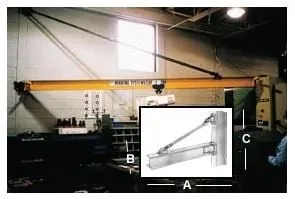Tie rod jib cranes are a cost-effective and efficient solution for material handling in various industrial settings. Designed to maximize workspace while minimizing structural requirements, these cranes are ideal for applications where floor space is limited or where existing structures can be utilized for support.
Understanding Tie Rod Jib Cranes
A tie rod jib crane is a type of wall-mounted crane that uses a tie rod to support the boom, allowing it to handle loads effectively without the need for a full mast. This design not only reduces material costs but also simplifies installation. The crane consists of a horizontal boom attached to a vertical support structure, with a tie rod providing additional stability. This configuration enables the crane to handle tensile loads efficiently, making it suitable for various industrial applications.
Key Features and Benefits
-
Space Efficiency: By mounting directly to a wall or existing column, tie rod jib cranes eliminate the need for floor-mounted supports, preserving valuable floor space for other operations.
-
Cost-Effective: The use of a tie rod instead of a full mast reduces material requirements, making these cranes one of the most economical options for hoist coverage.
-
Wide Coverage: Typically offering up to 200 degrees of rotation, tie rod jib cranes provide extensive coverage, facilitating the movement of materials across a broad area.
-
Versatility: Ideal for individual workstations, these cranes can also complement larger overhead crane systems, enhancing overall material handling efficiency.
Applications
Tie rod jib cranes are versatile and can be utilized in various settings, including:
-
Manufacturing Facilities: For tasks such as assembly, welding, and material transfer between workstations.
-
Warehouses: Assisting in loading and unloading operations, especially in areas with limited floor space.
-
Maintenance Areas: Providing support for equipment repairs and routine maintenance tasks.
Considerations for Implementation
When considering the integration of a tie rod jib crane into your facility, it's essential to assess the following:
-
Structural Integrity: Ensure that the wall or column intended to support the crane can withstand the imposed loads.
-
Headroom Requirements: Tie rod jib cranes require sufficient clearance throughout the arc of the boom to accommodate the tie rod suspension.
-
Capacity and Span: Determine the appropriate load capacity and boom length based on your specific material handling needs.
Conclusion
Tie rod jib cranes offer a practical and economical solution for enhancing material handling capabilities within various industrial environments. Their space-saving design, cost-effectiveness, and versatility make them an excellent choice for facilities aiming to improve operational efficiency without significant structural modifications.
Check out Our Tie Rod Jib Cranes!
